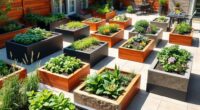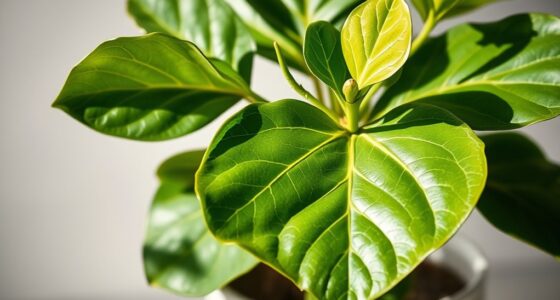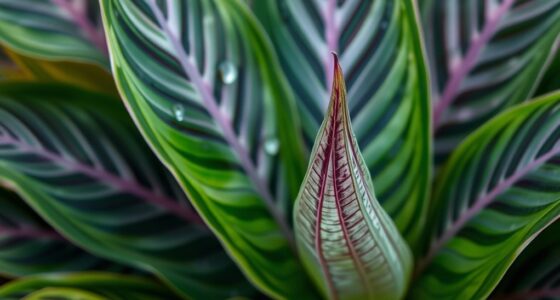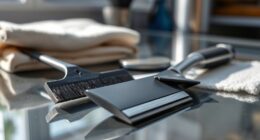To care for a bird of paradise indoors, place it near south- or west-facing windows for plenty of bright, indirect light, and rotate it regularly for even growth. Water when the top soil feels dry, and use well-draining soil to prevent root rot. Keep humidity high with misting or a pebble tray, and maintain temperatures between 65°F and 85°F. Prune and repot as needed to keep your plant healthy—keep exploring to learn more tips for thriving indoors.
Key Takeaways
- Place near south- or west-facing windows for bright, indirect light; rotate regularly for even growth.
- Water when top 2-3 inches of soil are dry, ensuring well-draining soil and proper drainage to prevent root rot.
- Maintain humidity between 50-70% with misting or humidifiers; keep temperatures between 65°F and 85°F.
- Fertilize every 6-8 weeks during active growth with water-soluble fertilizer; reduce feeding in winter.
- Prune dead or yellowing leaves, repot every 2-3 years, and check for pests like spider mites or scale.
Understanding the Light and Placement Needs

To help your Bird of Paradise thrive indoors, it’s essential to understand its light and placement needs. This indoor plant prefers bright, indirect light, but some varieties can handle up to 6 hours of direct sunlight daily. Position it near south- or west-facing windows where it can get ample natural light, especially in sunny spots. Proper placement guarantees the light exposure meets its light requirements, supporting healthy, lush foliage and flowering. Avoid low-light environments, as insufficient sunlight can lead to weak growth and prevent blooming. Rotate the plant regularly to ensure even light conditions, preventing uneven growth. If natural light is limited, supplement with grow lights to promote healthy development and flowering. Your careful placement and light management will keep your Bird of Paradise vibrant and thriving indoors. Additionally, using durable materials in potting and placement helps ensure the plant remains healthy and resilient in your home environment. Ensuring proper light exposure is crucial for the plant’s overall health and flowering potential. Properly managing light levels can also help prevent stress and encourage optimal growth.
Watering, Soil, and Fertilization Tips
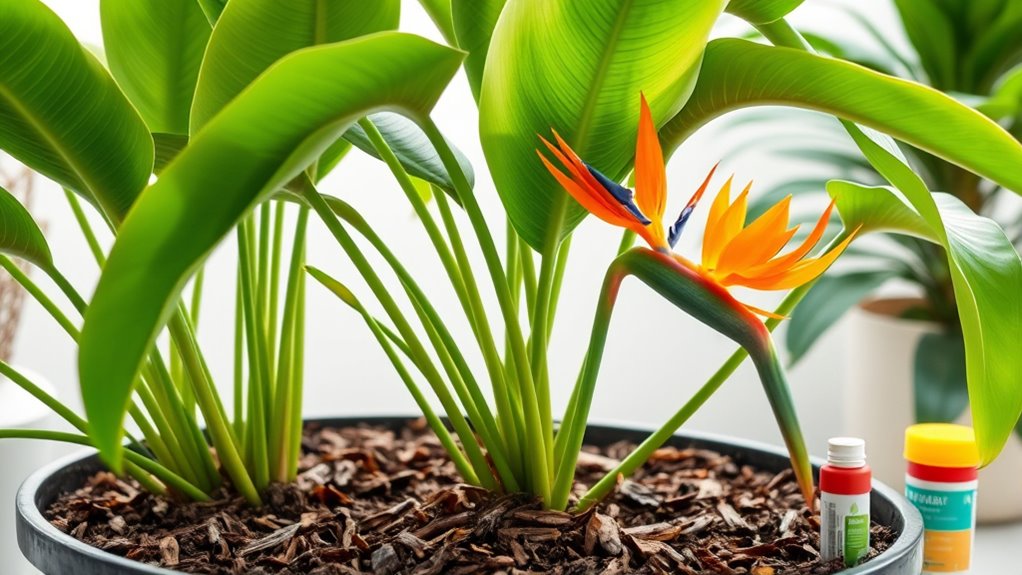
Ensuring proper watering, soil, and fertilization is key to keeping your Bird of Paradise healthy indoors. Use a consistent watering schedule, watering when the top 2-3 inches of soil feel dry, typically every 1-2 weeks. Choose well-draining soil mixes like peat, perlite, or sand for ideal moisture control and aeration. Make sure your pot has drainage holes and consider adding a drainage layer to prevent waterlogging and root rot. Fertilize every 6-8 weeks during the growing season with a water-soluble fertilizer, adjusting based on growth. During winter, reduce watering and skip fertilization to avoid stressing the plant. Proper soil, watering, and fertilization promote healthy roots and meet the plant’s nutrient requirements. Being mindful of watering frequency and avoiding overwatering are essential to prevent issues like root rot. Additionally, selecting well-draining soil can significantly improve moisture management and plant health. Using appropriate fertilization techniques ensures your plant receives necessary nutrients without risking overfeeding. Maintaining consistent care routines helps ensure the long-term vitality of your Bird of Paradise.
Maintaining Humidity and Temperature Conditions
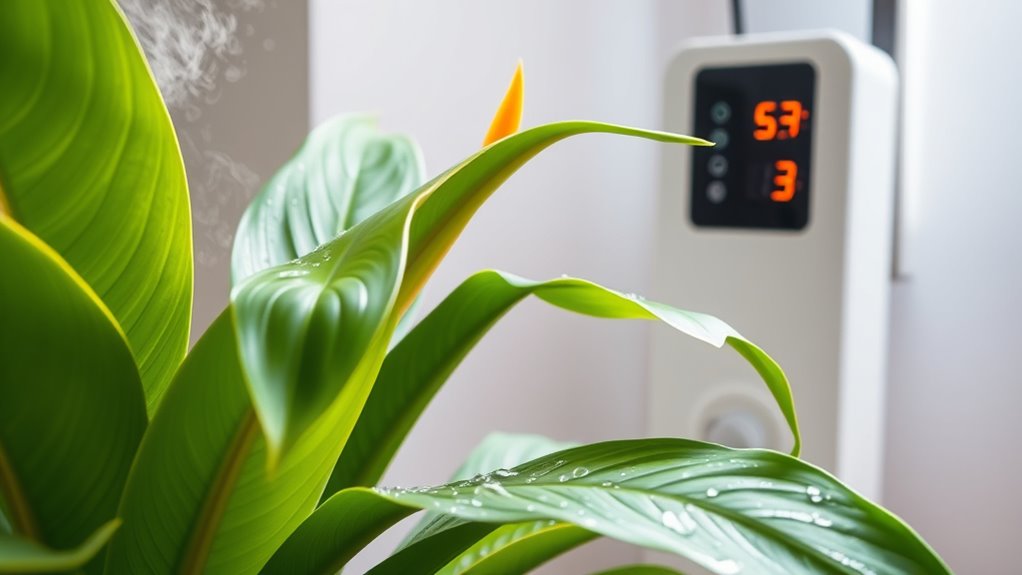
Maintaining essential humidity and temperature levels is vital for your Bird of Paradise to thrive indoors. Aim for humidity levels between 50-70%, which helps prevent leaf tips from browning and splitting. If your indoor environment has dry air, consider misting the leaves regularly, using a humidifier, or placing the plant on a pebble tray filled with water to boost moisture.
Keep the temperature range between 65°F and 85°F; temperatures below 60°F can cause cold stress or damage. During winter, reduce heating and avoid dry indoor air sources.
Also, guarantee your plant stays away from drafts, air vents, and dry heat sources, as these can disrupt stable humidity and temperature conditions and hinder healthy growth.
Pruning, Repotting, and Propagation Techniques
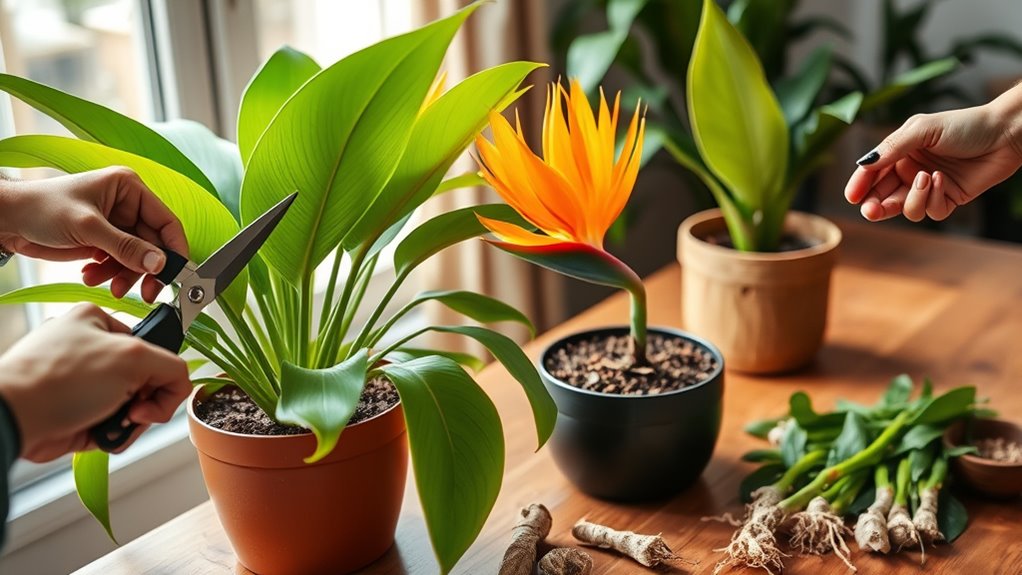
Pruning, repotting, and propagating your Bird of Paradise are essential steps to keep it healthy and vigorous. Regular pruning removes dead or yellowing leaves at the base, promoting airflow and healthy growth. Incorporating automation technologies can also assist in monitoring and maintaining optimal conditions for your indoor plants.
Regular pruning, repotting, and propagation keep your Bird of Paradise healthy and thriving.
Repotting every 2-3 years in spring involves choosing a slightly larger pot with well-draining soil to support plant growth. During repotting, gently loosen healthy roots and prune damaged ones to prevent root disturbance and encourage strong root development.
For propagation, division is effective—carefully separate rhizomes with at least one shoot attached. You can also propagate by seed germination, planting fresh seeds in moist, well-draining soil and maintaining warm temperatures around 70°F.
Incorporating diversification in your indoor garden can help ensure your Bird of Paradise remains vibrant and thriving indoors.
Troubleshooting Common Issues and Pests
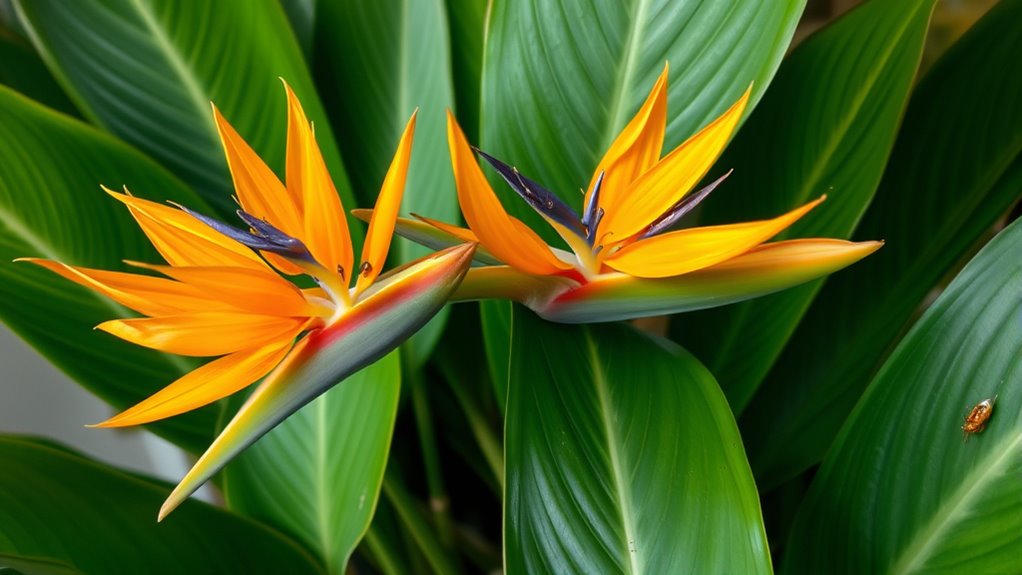
When your Bird of Paradise shows signs of distress, identifying and addressing common issues and pests promptly is key to keeping it healthy. Overwatering can cause droopy leaves, browning edges, and root rot—so let the soil dry 2-3 inches deep before watering again. Proper watering habits are essential for preventing these problems and maintaining overall plant health. Leaf splitting often results from low humidity or physical damage; increasing humidity with misting or humidifiers helps prevent this. A pest infestation, like spider mites, scale, or mealybugs, can be treated effectively with insecticidal soap or neem oil, applied thoroughly and regularly. Ensuring adequate light conditions is also crucial, as insufficient light can weaken the plant and make it more susceptible to pests and diseases. To troubleshoot: 1. Check for overwatering and adjust watering habits. 2. Increase humidity to prevent leaf splitting. 3. Inspect for pests and treat with appropriate solutions. Maintaining proper pruning, humidity, and light mimics its native environment for a healthier plant. Additionally, understanding the plant’s cultural significance helps tailor care practices for optimal growth. Recognizing the importance of plant care schedules ensures consistent health and vitality.
Frequently Asked Questions
How Do You Keep Birds of Paradise Alive Indoors?
To keep your bird of paradise alive indoors, you need to give it plenty of bright light, ideally 4 hours of direct or bright indirect sunlight daily.
Water it thoroughly when the top inch or two of soil feels dry, and guarantee proper drainage.
Maintain humidity around 50-70%, fertilize every two weeks during growth, and prune damaged leaves.
Regularly repot and clean the leaves to keep your plant healthy and thriving.
How Much Sunlight Does a Bird of Paradise Need?
Imagine your Bird of Paradise thriving in a sunny living room—it’s all about sunlight. You should provide it with 4 to 6 hours of bright, indirect light daily for healthy growth.
It can handle some direct sun in the morning or late afternoon, which boosts flowering. Place it near south or west windows for the best results.
Less light slows growth and hampers flowering, so guarantee ample sunlight.
How Often Do You Water a Bird of Paradise Houseplant?
You should water your Bird of Paradise houseplant every 1-2 weeks, letting the top 2-3 inches of soil dry out between waterings.
During spring and summer, you might need to water more often, while in fall and winter, cut back.
Always check soil moisture first with a meter or probe to prevent overwatering.
Water thoroughly until excess drains out, then remove any standing water from the saucer.
Where Should I Put My Bird of Paradise Plant in My House?
You might think any spot works, but the truth is, your Bird of Paradise needs the right environment to thrive. Place it near south or west-facing windows to get 4-6 hours of direct sunlight daily.
Keep it away from drafts and dry heat, and give it space to grow. A bright, spacious room with higher humidity, like a bathroom or kitchen, will help it flourish indoors.
Conclusion
With the right care, your bird of paradise will flourish like a tropical jewel in your home. Remember, providing ample light, consistent watering, and maintaining humidity creates a lush oasis for your plant to thrive. Think of it as nurturing a piece of paradise—your efforts will turn your space into a vibrant sanctuary. Stay attentive to its needs, and you’ll enjoy the stunning, exotic beauty of your indoor bird of paradise for years to come.

